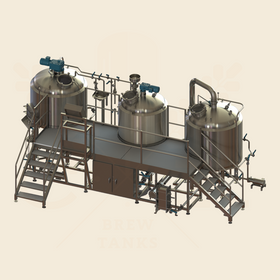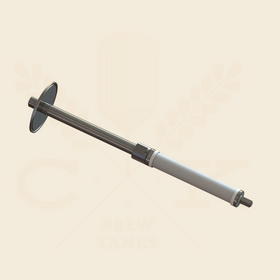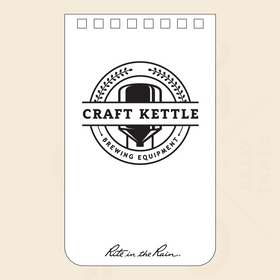
Knocking Out
You’ve been boiling the wort for close to an hour, tossing in hops when the recipe calls, and being cautious of a potential boil over. As the clock continues to move closer to your last hop additions, you should be prepared for your next step; “knock out”. This step of wort production, like so many others, involves many sub-steps.

From a general perspective, the knock out (also referred to as “cast out”), has two main goals; cool the wort, and move it into the fermenter. Though, anyone familiar with these blog posts know that “two main goals” translates to the many best practices involved. So let’s dig in to these best practices, because, after all, using such methods should translate to better beer…and if we’re not continually striving to make better beer, then what’s the point?
Mentioned in the previous blog post, the boiling phase is typically 60 minutes or longer (depending on the recipe), and is initiated with a correlating timer (60 min., 70 min., 80 min., etc.), which counts down to 0. Your recipe may have a “10 minute hop addition” or a “5 minute hop addition” just before the end of the boil, or perhaps even a “whirlpool hop” addition after the boil. These later addition hops have more of an influence on the hop flavor and aroma than their early addition counterparts, which mainly contribute to isomerized bitterness (see the “boiling” post for more details).
Following these later boil additions, the brewer finally reaches the end of the boil, or “flame out”. The actual evaporation rate, can be assessed here by measuring the post-boil volume of the wort in the kettle. Inconsistent evaporation rates overtime may indicate issues with the heating source. After the volume is noted, the brewer moves on to the next phase; the whirlpool.
As the name implies, the whirlpool simply consists of spinning the previously boiled wort in one direction. Remember those coagulated proteins the boil creates? Well, this centrifugal spin, plus a resting period, allows for those formed proteins and solids (i.e.; hops, grains, etc.) to gather in the center of the kettle. The spinning is useless though, without following it with a resting period, known as the whirlpool rest. So overall, the whirlpool might consist of a 20 minute process; 5 minutes of actual spinning, and 15 minutes of resting.
Whirlpool effects can be well demonstrated by spinning a closed jar containing water and small, lightweight, yet sinkable solids (a pickle jar containing only spices and vinegar works well too). Move the jar continuously, and swiftly around a circle with a diameter of a foot for a minute or so, then let the jar sit. You will notice all of the small solids slowly make their way to the center of the jar after spinning. Pretty neat, huh? Okay, end of experiment; put the pickle juice back in the fridge for future Bloody Marys.

Photo: The tangential arrows above represent the flow of wort during a whirlpool, and the arrows pointing toward the center represent solids settling in the vessel during a whirlpool rest.
Just as a mash tun is equipped to mash and lauter in the same vessel, modern boil kettles are built to allow the boil and whirlpool all in one. Home brewers know that a whirlpool can be achieved simply by swirling the wort with a large spoon or wooden stick in one direction, this is usually not practical for commercial scale brewing though. Modern boil kettles are often equipped with a pump capable of recirculating fluids inside the vessel, or capable of sending fluids to another vessel. This centrifugal pump usually draws wort from a lower or side port, and then sends the flow of wort at a tangential angle to facilitate the spinning needed for a whirlpool.
Remember terms like vorlauf, lauter, or grist? Well we’ve got another one to add to your brewing terminology; trub (pronounced ‘troob’). This term of likely German-origin, refers to solids (mainly protein and hops) that the brewer is trying to settle in the center of the vessel. Some boil kettles may even have a welded “stand plate” in front of the knock out port. Such a plate is added to retain as much of the trub pile in the center of the vessel as possible.

Photo: While not the most appealing to look at, this is an example of a compact trub pile formed because of a well-executed whirlpool and whirlpool rest.
Once the whirlpool rest is over, the brewer is ready to officially knock out. It is important to remember that time is of the essence in regards to actually starting the knock out. Remember that cooked corn off-flavor we discussed in the boiling blog post? Well, the chemical compound (Dimethyl Sulfide) that causes this flavor is formed at wort and mash “cooking” temperatures. Some recipes will be more susceptible to this flavor than others. However, brewers should be aware that as the previously boiled wort cools off during the whirlpool/whirlpool rest, the more potential there is for this off-flavor to be formed the longer the wort sits at these “cooking” temperatures.
And finally, our last wort handling step has arrived; knock out. But are you sure you’re ready for it?
- Do you have a cleaned and sanitized fermenter to send the wort into?
- Do you have a healthy, accurate yeast supply?
- Is your cooling and oxygen source ready?
These checklist-type questions should be going through every brewer’s head before starting. Even if it means prolonging the whirlpool, it is imperative to have all of these in order. If yes, then send it to the wort way (the flow path encompassing the wort from the kettle to the fermenter).
The brew kettle pump used for the whirlpool, likely will be used again to send the wort to the fermenter during knock out. Some brew kettles may be equipped with multiple outlets or exits for the wort to be “drawn” from, the idea being to achieve a balanced and equal flow from all sides of the kettle.

Photo: An example of slowly “drawing” the wort from the boil kettle, and minimizing disruption or “sucking in” of the trub pile.
The brew kettle pump, drawing from these outlets, then sends the wort into the heat exchanger. Home brewers may effectively cool wort using a submersible chiller, but this is impractical on a commercial scale. Instead, commercial brewers rely on cooling using a plate heat exchanger. The concept is similar to the forces at work in your car’s radiator.

Photo: This example shows red arrows (hot wort) entering the HE. The wort is then directed in a parallel, yet opposite direction of the cold water (blue arrows). As the hot wort transfers heat to the cold water, it leaves the HE at a decreased temperature (shown by yellow arrows). Likewise, as the cold water (shown by blue arrows) is heated by the hot wort, it leaves the HE at an increased, warmer temperature (also shown by yellow arrows).
This plate heat exchanger allows for a rapid decrease of temperature from near boiling to room temperature or colder. Such temperature drops stop the DMS formation described earlier, and provide ideal conditions for brewer’s yeast. Conveniently, most plate heat exchangers direct the warm water outlet to the hot liquor tank. Collecting this water and energy (heat) allows for cost savings as it can then be used for future batches or other brewery needs. Some heat exchangers may even be equipped to use the refrigerant glycol, in addition to colder water, in an effort to use less water or to speed up the cooling process. The wort existing the plate heat exchanger, now at room temp or colder, is heading toward the fermenter. Before it gets there, there are likely two more steps along the way; the yeast pitch and aeration.
Don’t ask me why it’s not called the “yeast addition” or “yeasting the wort”. Nonetheless, brewers refer to this sub-step as the “yeast pitch”, which I suppose is more fun than “yeast addition”. But it simply means adding the yeast to the wort. Breweries likely have a “yeast brink” which stores their healthy yeast. This brink is often hooked up to the wort way, so that yeast can be directly pitched “in-line”. Brewers might also opt for a “cone to cone” pitching method, which means pitching the yeast after filling the fermenter with wort, then using a previously fermented batch’s yeast (taking it from the bottom of the fermenter or “cone”) and adding it to the newly filled fermenter’s cone.
While yeast pitching methods may vary from brewery to brewery, wort aeration is typically always done in-line for commercial brewing. It is important to note, that in regards to the entire brewing and cellaring process, this is the only time brewers deliberately wish to add oxygen. It was mentioned in the lautering post that oxygen uptake by wort can result in numerous off-flavors in the end beer. So why add it then?
Briefly delving into microbiology, yeast are known as facultative anaerobes. This means that they can carry out metabolic processes in either aerobic (oxygen) or anaerobic (non-oxygen) environments. How they act under these specific conditions will surely be mentioned in a future blog post, but for today’s purposes, we are answering one question; why add oxygen at this step?
By adding oxygen, we are providing an aerobic environment for the yeast. This environment favors yeast cell reproduction. In particular, adding oxygen helps the yeast create new, healthy cell membranes, which translates to overall healthier daughter cells (new yeast cells formed). These new, healthy cells are better suited to handle fermentation of wort and to live longer for subsequent batches to be made.
The amount of oxygen being added is imperative, as different yeast strains react differently to varying amounts. As a general rule of thumb, 10 ppm is a good starting point for ales. Lagers, requiring a longer fermentation timeline, are likely better suited for a slightly higher amount. Improper aeration can negatively affect cell multiplication, which can translate to pour yeast health or struggling fermentations. Oxygen rates can be difficult to dial in, especially for certain yeast strains. Consider starting with a more oxygen-tolerable strain until your brewing system is better understood.
Pure oxygen is commonly used, where it is hooked up directly in-line to the wort way. From the oxygen tank, it is usually delivered to an oxygen stone. This stone breaks up the oxygen supply into tiny bubbles that are better and more evenly distributed into the wort.
An air compressor can also be used, but doing so involves further consideration. Air contains less oxygen (roughly 20%) so more must be used to obtain the correct parts per million of oxygen. Additionally, a sterile air filter must be added to ensure clean air is going in. Two negative side effects come from using air: The first is that you are aerating the wort even more, potentially producing more oxidized off-flavors. The second is that adding more air in-line tends to create foam, which could be messy or cause the brewer to lose wort.
Finally! The wort has made it to the bottom of the fermenter. Yes, we fill the fermenter from the bottom up. There are just two more “to do’s” for the brewer (well, ignoring the fact that he or she may have a brewhouse to clean). In regards to the fermenter though, the brewer needs to first set the fermentation temperature. All living organisms, including yeast, produce heat. If the fermentation temperature is not controlled by a refrigerant (glycol), this excess heat can potentially produce (you guessed it) off-flavors in the end beer. Some recipes/yeast strains may, however, perform more optimally or release desired flavor/aroma characteristics at warmer temperatures. The brewer should know the optimal temperature for the yeast strain they are fermenting with.
Lastly, take a sample; did you hit the gravity you were going for? How about pH? How’s it taste? Sure, it’s not beer, but a lot can be noted from this wort sample. Asking and answering such questions helps the brewer become more consistent overtime.
Was this your first knock out on a new system? If so, then congrats! That’s a big moment, and surely one that deserves a celebratory pint!
Happy brewing.
Photo References:
Whirlpool dynamics:
https://byo.com/article/whirlpool-dynamics-the-physics-of-trub-removal/
Whirlpool with trub pile:
Trub pile:
Heat exchanger:




